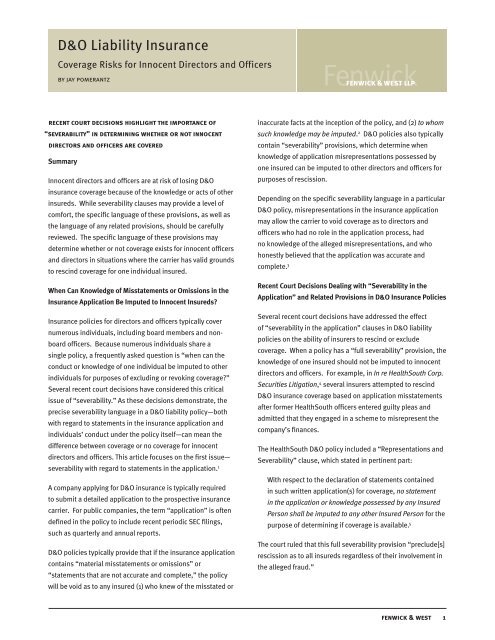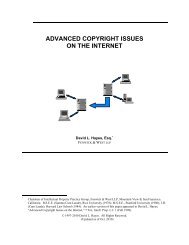D&O Liability Insurance-Coverage Risks for Innocent Directors and ...
D&O Liability Insurance-Coverage Risks for Innocent Directors and ...
D&O Liability Insurance-Coverage Risks for Innocent Directors and ...
Create successful ePaper yourself
Turn your PDF publications into a flip-book with our unique Google optimized e-Paper software.
D&O <strong>Liability</strong> <strong>Insurance</strong><strong>Coverage</strong> <strong>Risks</strong> <strong>for</strong> <strong>Innocent</strong> <strong>Directors</strong> <strong>and</strong> Officersby jay pomerantzrecent court decisions highlight the importance of“severability” in determining whether or not innocentdirectors <strong>and</strong> officers are coveredSummary<strong>Innocent</strong> directors <strong>and</strong> officers are at risk of losing D&Oinsurance coverage because of the knowledge or acts of otherinsureds. While severability clauses may provide a level ofcom<strong>for</strong>t, the specific language of these provisions, as well asthe language of any related provisions, should be carefullyreviewed. The specific language of these provisions maydetermine whether or not coverage exists <strong>for</strong> innocent officers<strong>and</strong> directors in situations where the carrier has valid groundsto rescind coverage <strong>for</strong> one individual insured.When Can Knowledge of Misstatements or Omissions in the<strong>Insurance</strong> Application Be Imputed to <strong>Innocent</strong> Insureds?<strong>Insurance</strong> policies <strong>for</strong> directors <strong>and</strong> officers typically covernumerous individuals, including board members <strong>and</strong> nonboardofficers. Because numerous individuals share asingle policy, a frequently asked question is “when can theconduct or knowledge of one individual be imputed to otherindividuals <strong>for</strong> purposes of excluding or revoking coverage?”Several recent court decisions have considered this criticalissue of “severability.” As these decisions demonstrate, theprecise severability language in a D&O liability policy—bothwith regard to statements in the insurance application <strong>and</strong>individuals’ conduct under the policy itself—can mean thedifference between coverage or no coverage <strong>for</strong> innocentdirectors <strong>and</strong> officers. This article focuses on the first issue—severability with regard to statements in the application. 1A company applying <strong>for</strong> D&O insurance is typically requiredto submit a detailed application to the prospective insurancecarrier. For public companies, the term “application” is oftendefined in the policy to include recent periodic SEC filings,such as quarterly <strong>and</strong> annual reports.D&O policies typically provide that if the insurance applicationcontains “material misstatements or omissions” or“statements that are not accurate <strong>and</strong> complete,” the policywill be void as to any insured (1) who knew of the misstated orinaccurate facts at the inception of the policy, <strong>and</strong> (2) to whomsuch knowledge may be imputed. 2 D&O policies also typicallycontain “severability” provisions, which determine whenknowledge of application misrepresentations possessed byone insured can be imputed to other directors <strong>and</strong> officers <strong>for</strong>purposes of rescission.Depending on the specific severability language in a particularD&O policy, misrepresentations in the insurance applicationmay allow the carrier to void coverage as to directors <strong>and</strong>officers who had no role in the application process, hadno knowledge of the alleged misrepresentations, <strong>and</strong> whohonestly believed that the application was accurate <strong>and</strong>complete. 3Recent Court Decisions Dealing with “Severability in theApplication” <strong>and</strong> Related Provisions in D&O <strong>Insurance</strong> PoliciesSeveral recent court decisions have addressed the effectof “severability in the application” clauses in D&O liabilitypolicies on the ability of insurers to rescind or excludecoverage. When a policy has a “full severability” provision, theknowledge of one insured should not be imputed to innocentdirectors <strong>and</strong> officers. For example, in In re HealthSouth Corp.Securities Litigation, 4 several insurers attempted to rescindD&O insurance coverage based on application misstatementsafter <strong>for</strong>mer HealthSouth officers entered guilty pleas <strong>and</strong>admitted that they engaged in a scheme to misrepresent thecompany’s finances.The HealthSouth D&O policy included a “Representations <strong>and</strong>Severability” clause, which stated in pertinent part:With respect to the declaration of statements containedin such written application(s) <strong>for</strong> coverage, no statementin the application or knowledge possessed by any InsuredPerson shall be imputed to any other Insured Person <strong>for</strong> thepurpose of determining if coverage is available. 5The court ruled that this full severability provision “preclude[s]rescission as to all insureds regardless of their involvement inthe alleged fraud.”fenwick & west
In some circumstances, however, courts have found thata D&O policy includes only partial severability. Under“partial severability,” misrepresentations or omissions bysigners of the application or other designated individualsmay be imputed to other insureds. In one such case, theinsurance carrier rescinded the D&O policy based on allegedmisrepresentations made by the CFO, who signed therenewal application. The policy included a “Severability ofApplication” provision, which stated in pertinent part:In the event that the Application . . . containsmisrepresentations made with the actual intent to deceive,or contains misrepresentations which materially affect …the acceptance of the risk[,] . . . this Policy in its entiretyshall be void <strong>and</strong> of no affect whatsoever; <strong>and</strong> provided,however, that no knowledge possessed by any Directoror Officer shall be imputed to any other Director or Officerexcept <strong>for</strong> material in<strong>for</strong>mation known to the person orpersons who signed the Application. 6The trial court ruled that the provision was unambiguous <strong>and</strong>clearly provided that “a director’s or officer’s knowledge ofa misrepresentation made with an intent to deceive is notimputed to other directors or officers unless the application’ssigner knew of the misrepresentation.” The court found thatthe CFO knowingly submitted materials with the renewalapplication that included material misrepresentations.Consequently, the insurer was entitled to rescind coverage <strong>for</strong>otherwise innocent officers <strong>and</strong> directors. The Ninth Circuitupheld the trial court’s ruling on appeal.A similar outcome was reached in a recent Ninth Circuit case.In Federal <strong>Insurance</strong> Co. v. Homestore, Inc., the insuredsappealed a decision granting rescission as to all insureds.The carrier contended that it was entitled to such rescissionbecause of material misrepresentations made by the <strong>for</strong>merCFO, who signed the insurance application.The Homestore D&O policy included a “Representations”section, which stated:[I]n the event that the Application, including materialssubmitted herewith, contains misrepresentations[,]… no coverage shall be af<strong>for</strong>ded … <strong>for</strong> any Director orOfficer who did not sign the Application but who knewon the inception date of this Policy the facts that were somisrepresented, <strong>and</strong> this Policy in its entirety shall be void<strong>and</strong> of no effect whatsoever if such misrepresentationswere known to be untrue on the inception date of thePolicy by one or more of the individuals who signed theApplication. 7The insureds argued that this language was not clear <strong>and</strong>should be construed in their favor. Instead, the NinthCircuit found as a matter of law that the Representationssection did not limit the carrier’s ability to rescind the policyonly to the particular insureds who had prior knowledgeof the misrepresentations. Reading the Representationssection as a whole, the court concluded that the partiesclearly intended to permit rescission (1) as to any insuredwho had prior knowledge of a material misrepresentationin the insurance application, <strong>and</strong> (2) as to all insureds ifsuch misrepresentation was known to any signer of theapplication. Accordingly, the appellate court found the clauseunambiguous <strong>and</strong> ruled that it permitted the rescissionof coverage <strong>for</strong> innocent directors <strong>and</strong> officers if materialmisrepresentations were known to any person who signed theapplication. 8Even where D&O policies contain a seemingly unambiguous“full severability” provision, carriers have attempted torescind or exclude coverage. For example, in a recentCali<strong>for</strong>nia state court case, the policy specifically provided <strong>for</strong>full severability, stating that “no knowledge or in<strong>for</strong>mationpossessed by one insured [regarding statements in theapplication] shall be imputed to any other insured <strong>for</strong>purposes of determining the availability of coverage underthis Policy.” 9 The insureds conceded that the <strong>for</strong>mer CEO,who signed the application, had failed to disclose adversematerial in<strong>for</strong>mation therein. However, relying on the policy’sfull severability provision, the insureds argued that coverageshould not be denied to innocent directors <strong>and</strong> officers basedmerely on the <strong>for</strong>mer CEO’s misrepresentations.The carrier rejected this argument <strong>and</strong> sought a declarationthat it could deny coverage as to all insureds <strong>for</strong> any claimsarising from facts <strong>and</strong> circumstances that should have beendisclosed in the application. The carrier argued that theapplication itself contained unambiguous language excludingclaims arising from facts or circumstances known at the timethe application was signed:No person(s) or entity(ies) proposed <strong>for</strong> this insuranceis cognizant of any fact, circumstance or situation whichthey have reason to suppose might af<strong>for</strong>d grounds <strong>for</strong> anyclaim such as would fall within the scope of the proposedinsurance . . . . [A]ny claim arising from any claims, facts,circumstances or situations required to be disclosed . . . isexcluded from the proposed insurance.The carrier further argued that the policy’s full severabilityprovision had no effect on this claim exclusion in the d&o liability insurance—coverage risks <strong>for</strong> innocent directors <strong>and</strong> officers fenwick & west
application, because the latter did not depend upon imputedknowledge to exclude undisclosed claims.The court agreed that when the application’s claim exclusionwas read in isolation, the mutual intent of the parties was toexclude coverage <strong>for</strong> innocent directors <strong>and</strong> officers based ona failure by one insured to disclose in<strong>for</strong>mation. However, thecourt ruled that the application could not be read in isolation,but rather should be read in conjunction with the policy’s fullseverability provision. In so ruling, the court stressed thatthe full severability provision had been added to the policyby amendment, indicating an intent by the insureds to securecoverage <strong>for</strong> innocent directors <strong>and</strong> officers. 10The court concluded that the existence of both theapplication’s claim exclusion <strong>and</strong> the severability provisionwithin the same policy created an ambiguity regarding theproper construction of the policy. Under Cali<strong>for</strong>nia law,“ambiguous terms are resolved in the insureds’ favor,consistent with the insureds’ reasonable expectations.”The court found that the insureds’ objectively reasonableexpectation was that the severability provision appliedto the entire policy. Accordingly, the court ruled that theexclusionary language in the application did not precludecoverage <strong>for</strong> innocent insureds.This case demonstrates the critical importance of looking pastthe severability clause. Even in situations where the policyincludes full severability or the insureds specifically negotiatefull severability in an endorsement, innocent directors <strong>and</strong>officers may not be covered. Instead, all relevant policyprovisions, including language in the insurance applicationor in any “warranty” or “representation” letter requested bythe carrier, should be closely analyzed to determine whetherany language exists that arguably contradicts the severabilityprovision.If you have questions please contact:Jay L. Pomerantz, Partner, Securities Litigation Groupjpomerantz@fenwick.com, 650-335-7697©2006 Fenwick & West LLP. All Rights Reserved.Endnotes1D&O policies also typically contain a second severability provision,which defines when certain specified conduct by one individualinsured, such as intentional fraud or criminal acts, can be imputedto other individual insureds (or the company) <strong>for</strong> purposes ofinvoking the policy’s conduct exclusions.2In addition, state insurance law generally imputes these conditionsinto the policy. More broadly, state law provides guidelines<strong>for</strong> interpreting insurance policies, including detailed statutoryprovisions in many jurisdictions. The intricacies of individualjurisdictions’ approaches to insurance policy interpretation isbeyond the scope of this article.3This article focuses on when knowledge or conduct of oneindividual insured can be imputed to other individual insureds.An equally important issue beyond the scope of this article iswhether <strong>and</strong> when knowledge or conduct of an individual insuredcan be imputed to the company <strong>for</strong> purposes of rescinding orexcluding coverage as to the company.4308 F. Supp. 2d 1253 (N.D. Ala. 2004).5In re HealthSouth Corp. Ins. Litig., 308 F. Supp. 2d 1253, 1261 (N.D.Ala. 2004) (emphasis added).6Cutter & Buck, Inc. v. Genesis Ins. Co., 306 F. Supp. 2d 988, 1011(W.D. Wash. 2004) (emphasis added), aff’d, No. 04-35218, 2005 WL1799397 (9th Cir. Aug. 1, 2005).7Fed. Ins. Co. v. Homestore, Inc., No. 03-55995, 2005 WL 1926483, at*1 (9th Cir. Aug. 12, 2005) (emphasis added).8In a parallel state court action, a Cali<strong>for</strong>nia court reached the sameconclusion. See TIG Ins. Co. of Michigan v. Homestore, Inc., 40 Cal.Rptr. 3d 528 (Cal. Dist. Ct. App. 2006).9See Twin City Fire Ins. Co. v. HPL Techs., Inc., No. 1-03-CV-006505,slip op. at 6 (Cal. Super. Ct. Santa Clara Co. Jan. 12, 2005).10See also Shapiro v. Am. Home Assurance Co., 616 F. Supp. 900,904 (D. Mass. 1985) (ruling that “the severability clause should betaken as the manifest intent of the parties since it appears in anaddendum to the policy”).this update is intended by fenwick & west llp tosummarize recent developments in the law. it is notintended, <strong>and</strong> should not be regarded, as legal advice.readers who have particular questions about theseissues should seek advice of counsel. d&o liability insurance—coverage risks <strong>for</strong> innocent directors <strong>and</strong> officers fenwick & west
















